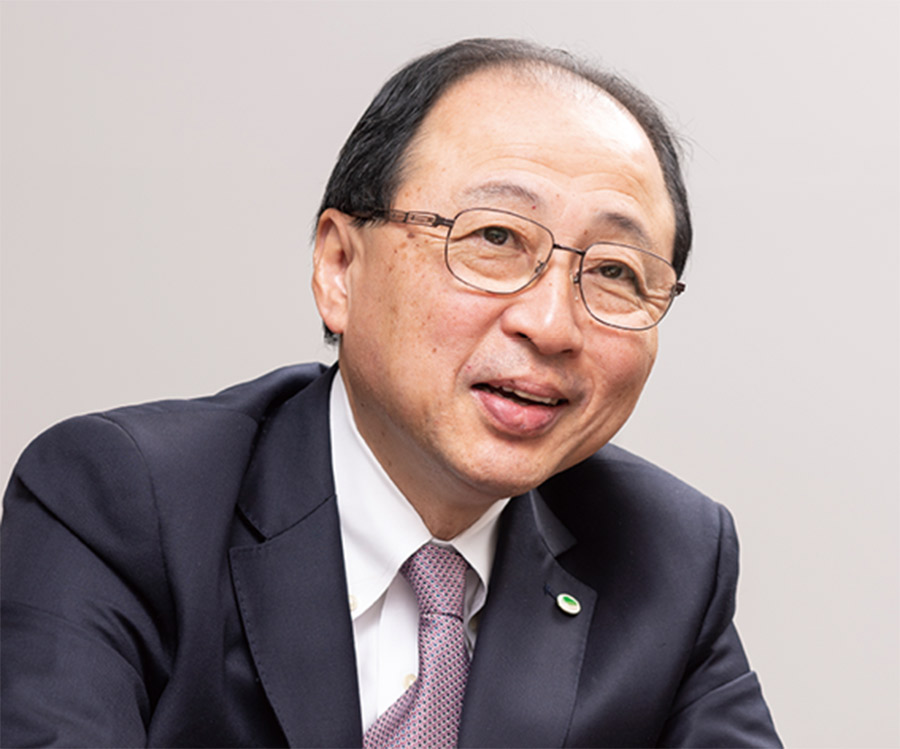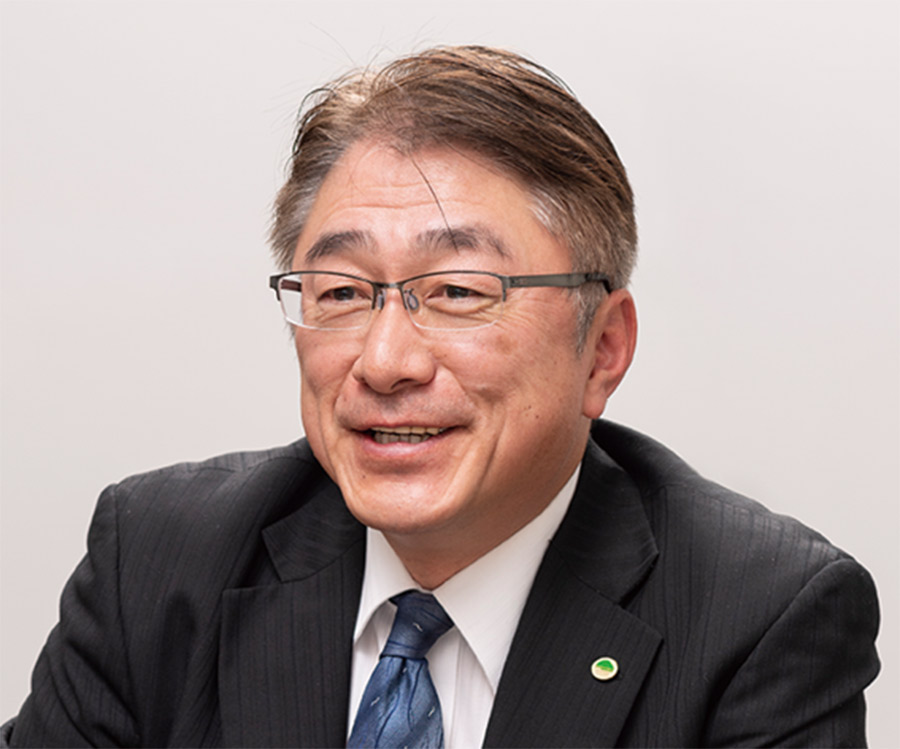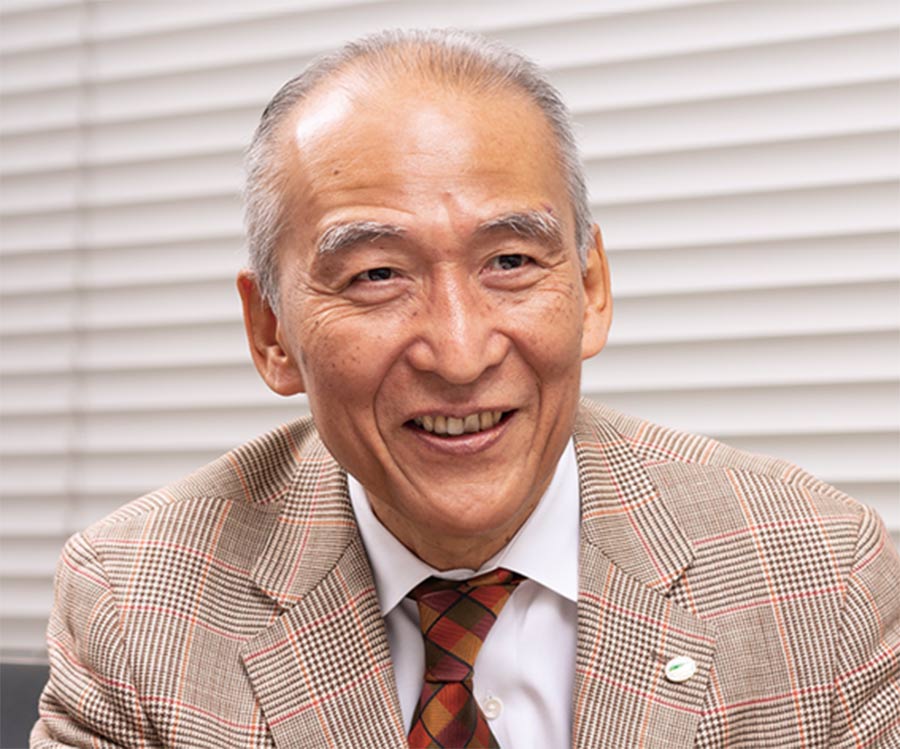Concepts Changing with Changing Environment

Yuji Toda
General Manager, Intellectual Property Division, Hitachi, Ltd.
The environment in which companies operate is currently undergoing major changes driven by the advance of globalization and digitalization. How do you deal with change from your own respective standpoints?
Toda:While intellectual property is an intangible asset, intellectual property mainly meant patents or trademarks for protecting tangible goods in the past. Digitalization, however, has raised the importance of data, know-how, experience, and knowledge, and these too have come to be regarded as intellectual property in a broad sense of the term. I believe that intellectual property in this sense will grow in importance to become the prime real estate of business as digitalization and globalization become a greater feature of corporate management.
Sugawara:I believe that opportunities to incorporate different technologies and business platforms than before through merger and acquisition (M&A), etc. for discontinuous business growth will increase. In MONOZUKURI, this will require us to adapt to drastic changes such as the integration and standardization of production techniques or systems that we have built up over time. The pace of change in society is also increasing, bringing about a time in which the concepts and practices of conventional MONOZUKURI based around “mother factories,” main factories in Japan, will be revised.
Ariyoshi:The big change in the area of human resources development and education is the rapid rise in diversity. While we intentionally sought to increase diversity in the past, it has suddenly increased all on its own as a result of M&A and therefore is something we need to properly address. To do so, we have started to introduce reforms that reflect these changes, including by taking a global view of fostering potential leaders and by running programs in technical training as well as other areas that are tailored to their respective countries or regions rather than being the same everywhere.
New Skills Needed as Nature of Globalization Changes

Sadayuki Sugawara
General Manager, MONOZUKURI Strategy Division, Hitachi, Ltd.
Tell me about the steps that are needed to turn this changing environment to your advantage. Could you start by talking about the globalization of management?
Toda:In the 1980s when I joined Hitachi, the globalization of intellectual property (IP) activities meant filing foreign patent applications and using them for protecting our products and licensing contracts. At that time, patent litigations were going on between Japanese and US companies in the electronics field and it is fair to say that we were in a different sort of difficult situation caused by globalization than that of the present day. Subsequently, Hitachi went through business restructurings that drew IP activities more closely into the core business. In the case of global business utilizing data in collaborative creation with overseas companies, the intellectual property in a board sense I talked about earlier would be the key to success. Because of the need to deal with rules that differ between different countries or regions, we pair up intellectual property staff with legal staff with good English skills to support contract work.
Because of the deepening of the relationship between business strategy and intellectual property brought about by these recent changes in the environment such as globalization, and also the rising number of situations where a broad range of decisions are called for, we have incorporated management elements into our own human resource development programs in the intellectual property division. Along with fundamental business education such as financial statements and strategic thinking, we have also been encouraging enrollment in Master of Business Administration (MBA) programs for about 10 years. Over the last few years, we have been promoting personnel exchanges with business divisions and thus acquiring a wide range of knowledge and human resources to support IP activities in global business.
Sugawara:In MONOZUKURI, globalization has to date meant things like establishing the infrastructure of overseas production based around “mother factories” in Japan. This is starting to change significantly. When seeking to achieve international growth through the acquisition of overseas companies, as we have done with the Railway Systems Business Unit of Hitachi, we need to develop a flexible infrastructure that allows all work from design through to production to be done wherever it makes the most sense, whether in Japan or overseas. Achieving this requires both mechanisms that enable the timely sharing of design information between sites and the global standardization of MONOZUKURI practices. Our mission at the MONOZUKURI Strategy Division is to advise business divisions on the best ways to organize global production systems, and we undertake this in parallel with implementation at the business divisions. The advantage of MONOZUKURI in Japan is the high level of workplace skill that enables people to come up with their own ideas and improvements. This contrasts with manufacturing in USA and Europe that features tight integration of IT systems and where the advantage lies in speed and a high degree of affinity with digital technology. Seeing the ideal manufacturing model as being one that combines the best of both, we are working on strengthening engineering chain management (ECM) and supply chain management (SCM), the objectives of which are to optimize operations to create a flexible global production infrastructure.
Ariyoshi:Human resource management is becoming more important than ever at this time when globalization and diversity are becoming the default for corporate activity. Human resources departments are engaging in major reforms, including the creation of databases and standardized grading. In 2017, we established our Hi-Next integrated platform that is intended to provide a clear view of human resources across the Hitachi group and enable optimal human resource management throughout the world. In education, we have launched strategic initiatives for equipping staff with new skills for the global era. The introduction by the intellectual property division of management education was mentioned earlier, and we are also being told by other business divisions that they want to foster people who are not just specialists but also artists. While specialist expertise remains essential, I think it is fair to say that having the ability to take personal responsibility for dealing with situations holistically is also an important skill in the global era.
Using Data to Change One’s Self

Tsukasa Ariyoshi
Board Director, L&D Division, Technology, Hitachi Academy Co., Ltd.
Next, could you tell me about what you are doing from your various perspectives to contribute to digital transformation and the use of data?
Toda:Hitachi promotes data utilization businesses using real data in the industrial field and the like. In order to support such businesses, the intellectual property division helps them write contracts for the use of customer data and also offers suggestions for improving their business models themselves. A variety of new knowledge has been created through the co-creation process. This in itself constitutes intellectual property, and we also hope to contribute to promoting the use of intellectual property using the framework of Lumada.
Sugawara:I believe that the utilization of digital technology will bring big changes to the field of MONOZUKURI. One could say that it is only thanks to the progress of digitalization that a flexible and global production infrastructure is possible, and the ways in which data is handled are changing from upstream design and development processes all the way to downstream manufacturing processes. In manufacturing processes in particular, digital data is used to represent various different situations and phenomena and this is making it comparatively easier to identify and find ways of solving issues that in the past were invisible to those without experience. At overseas factories, including those located in emerging nations, there are an increasing number of instances in which productivity improvements have been made through the use of data by even inexperienced staff.
What we have been engaged in over recent times has been increasing the speed and level of reforms and improvements by incorporate digital technology (in the form of tools) into the thinking behind industrial engineering (IE) that has long been the basis of productivity improvement. We have established an IE meister certification program to help spread IE practices and methods as well as to boost motivation.
Ariyoshi:With regard to education, as of April 1, 2019, we merged three existing institutions that served different sectors, the Hitachi Institute of Management Development for management, the Hitachi Information Academy Co., Ltd. for IT, and the Hitachi Institute of Technology for operational technology (OT) and products. This was done to help train staff who are able to cope with digital transformation. While consolidating systems that have developed independently in the past is not easy, our aim is to achieve comprehensive human resource development by adopting a uniform and standardized education system within Hitachi. Ahead of real-world educational institutions, we have consolidated our e-learning systems globally under the banner of Hitachi University and created an environment that delivers effective learning opportunities at appropriate timings to staff throughout the world.
Innovation in Open Communities
A third change is the rising level of activity surrounding open innovation and collaborative creation with customers. How are your different activities changing?
Toda:The intellectual property division participates in more than 300 co-creation projects annually and promotes partnerships utilizing intellectual property. One of the issues that has arisen out of this is how to deal with the background intellectual property (BGIP) brought in by Hitachi and the foreground intellectual property (FGIP) created jointly with our partner. The key lies in whether we are able to offer an intellectual property framework that provides a mutual win-win relationship while respecting the customer's own intellectual property.
Sugawara:When it comes to open innovation in MONOZUKURI, examples include production enhancements made through collaborative creation with leading companies in a range of fields. If we are to make comprehensive improvements in our own MONOZUKURI practices, it is important that we learn from such instances of collaborative creation with external partners and share the knowledge and concepts. Likewise, there is also scope for using improvements made at Hitachi to bolster resources for collaborative creation with customers.
Standardization and the development of new technologies are essential for the convergence of MONOZUKURI and digital technology. One practice that is proving effective is that of working groups drawn from right across Hitachi. The MONOZUKURI Strategy Division promotes working group activities by acting as an administrative facilitator. Currently active in 15 fields of technology, among such groups newly formed during 2018 are one for data scientists and another for procurement engineering. Given that they involve the sharing of information and examples of best practice in these fields across different departments and are spontaneous communities that aim to develop human resources, they can in a certain sense be described as in-house open innovation activities.
Ariyoshi:Technological communities that emerge by their own accord out of a rising need certainly constitute a fine tradition. In particular, the lack of textbooks for leading-edge technologies means that the way in which these exemplars of best-practice spur each other on is a lesson in itself. At a time when the pace of both technology and business is accelerating, education too is becoming more open and I anticipate that project-based learning (PBL) involving collaborative creation with customers will take on a central role in place of in-house classroom lessons or on-the-job training (OJT) in one's own department. The growing library of use cases in Lumada should also provide a new type of learning aid. As we enter the digital era, the environment is ripe for building up know-how of collaborative creation that can serve as an educational resource and rolling out the know-how across the organization. We intend to make good use of this environment to advance the reform of education.
How to Respond to Global Issues
Companies are expected to play their part in overcoming societal challenges such as those expressed by the United Nations' Sustainable Development Goals (SDGs) and in Japan's growth strategy based on Society 5.0. Please tell me about what you are doing in response to these expectations and requirements.
Toda:The intellectual property divisions of many companies, including Hitachi, were quick to address the SDGs. One of the examples is the WIPO GREEN program of the World Intellectual Property Organization (WIPO) that encourages the transfer of green technology. The program was established on the basis of a proposal to WIPO by the Japan Intellectual Property Association, which I have been involved with myself from an early stage. WIPO GREEN is a framework for matching companies providing a technology with other companies seeking such technology. When a company registers its intellectual property such as green technology, know-how, or services in the WIPO GREEN database, it allows the company to be matched with other companies seeking such technology. Hitachi has listed technology and know-how for the recycling of home appliances.
While we also intend to step-up our IP activities that contribute to the SDGs and Society 5.0 in other ways, the basic principle of intellectual property contributing to social issues is openness. I believe it is becoming more and more important to consider how to use intellectual property as a driving force for resolving major issues, while securing intellectual properties.
Sugawara:Among the initiatives in MONOZUKURI that address Society 5.0 is work on making manufacturing smarter. Crowd manufacturing forms part of this, meaning the sharing of manufacturing plant that is excess to requirements or underutilized, taking advantage of the flexible handling of design and production information in the form of digital data to make better use of this equipment. Hitachi is participating in its development.
To address environmental problems, we are working on improvements to the energy efficiency of production equipment, especially at factories such as those in China. We are also helping to create a low-carbon society, having introduced an internal carbon pricing system for use in business planning whereby we have put our own price on carbon emissions.
Ariyoshi:Because a common awareness of major societal-level issues and objectives is an essential prerequisite for collaborative creation with customers, in the case of things like selective training for leaders in particular, we make a point of using issues like the SDGs or Society 5.0 as a starting point. Starting with learning from examples, and with ongoing training that includes discussions that take account of design thinking, we engage in exercises that enhance people's ability to break down these major societal issues into matters that are relevant to business as well as one's own area of expertise.
Contributing to Progress of Social Innovation Business
With reference to the outcomes of Hitachi's 2018 Mid-term Management Plan, the progress of the Social Innovation Business is targeted under the newly formulated 2021 Mid-term Management Plan. Please tell me about your enthusiasm for the new challenge.
Toda:The process of resolving issues in social innovation has points in common with the process of invention, namely deciding the target field, determining the issues to address, writing up the solutions together with practical examples, and considering alternatives. By incorporating the concept of invention creation into education programs for not only engineers, but also sales staff, I believe we can help boost their ability to solve problems.
The intellectual property division is also taking on new activities that have few past precedents even among global companies, such as building ecosystems by utilizing intellectual property to expand the Social Innovation Business. I often borrow a quote from Charles Darwin that says, “It is not the strongest of the species that survives; it is the one most adaptable to change.” We will secure knowledge gained from failures through the new activities as intellectual property and will continue IP activities that adapt to change and look to the future.
Sugawara:To grow globally, MONOZUKURI needs to build a flexible production infrastructure that extends throughout the world. In the future, I intend to work with business divisions to accelerate the realization of MONOZUKURI with globally standardized high efficiency so as to contribute to sustainable growth throughout Hitachi.
Ariyoshi:In education, the era is over in which everything was done in accordance with what was laid down from on high, while of growing importance are things like the spontaneous communities I talked about earlier in which those exemplars of best-practice spur themselves on. The new role of training centers is to help strengthen the foundations of the company by supporting such people and working toward the creation of a knowledge cycle and education ecosystem.

